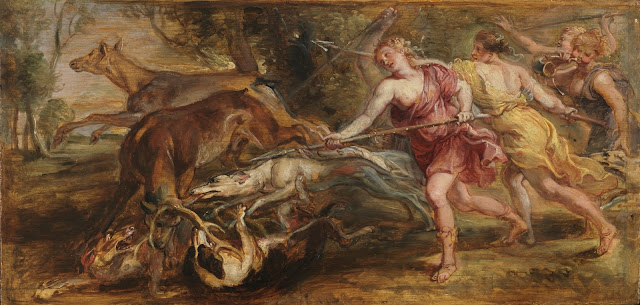Encountering a Muse Amidst a Totality of Dead Nature
One can imagine a strange melancholy in the Anglo relation to nature, the sense of connection is intensified at the very moment of its total loss. Just as a man sees the figure of his lost love in the swaying grasses of abandoned fields - one whom he betrayed through an indecisiveness more than anything else - the Anglo begins to see nature in its very domestication. A rising, fermented being of cultivation; the wildflowers encroaching upon the garden from out of the forest; the piles of shit and mud with pigs digging away at green rows; the mist of a dark sentiment of time; the weeding and soft warmth of decaying piles of seasons, the locks of Persephone as one wanders back into the house staggered but satisfied.
In holloways the simple farmer leaves petrifying wells, stone figures of trolls and the impossibility of descent upon this land from a higher and darker place. These are peaceful shadows trudged out by a wandering that has become an eternal and certain path. One cannot say that the arches of regrowth are lacking in beauty, they are perhaps the perfection of architecture. And so we must not condemn the Anglo for it has all been lost to all of us. And the last arches of the forests are now burning or desecrated by a single great figure of the Final Pilgrimage.
Memory is most intense in our holding onto its last strands, where we desperately refuse to let go and create all new paths - threatening our revenant lost love as a ward of the entire force of the dead. And so too does art become its great test in these moments, threatening total beauty or self-extraction into irrelevance. Tragedy walks this line between the total-work-of-art, with the totality remaining in its ineffable state, and absolute death, the abstraction of memory into itself.
Thus we can imagine the modern obsession with time and the decayed state of the image. Our attachment to melancholy becomes simple and beautiful through endurance. And all that endures begins to show a greater quality of materialisation, of wearing time against fate and the certain return of greater paths. We adore ruins and the pristine document equally, such is there similarity. And so it is that we appear as the spectral figures in the Adoration of the Magi, escaping into the formal background of the image as the encroachment of some unknown immediacy begins to tear away at any sense of occasion, memory, and song. A great horizon as an ward apotropaic symbol against the Muses. Here all difference between Da Vinci and Malevich disappears. Each work is the same in their eyes, and so formalism is all that we are left with.
Both the practitioners of beauty formalism and promethean instrumentation participate in the same ceremonies, and their bickering opposition is perhaps its own form of abstract art; much more symbolic of our monstrous times than any direct machine representation. This is regrowth, just as the forest deprived of human cultivation begins to set upon itself, drowning in branches and death, the pure survival of abandonment until it becomes impossible to return. Eternally a lost infant, just like us. Either total management or the judgement of self-imposed Darwinism, not unlike the philosophy of art in its bare formalities.
Performance is lost to us as art becomes its own being. It escapes, and the chasm between our own reality and that of the Muses requires an unending and impossible assembly of defense. Any attempt to reverse engineer art is doomed to fail as the catastrophic appearance of the impossible object, the eternal material, and the fall from memory are completely at odds with the instrumentalised mind. Thus we formalise them, turn them into impossible idols of their own self-propulsion eternity. And so time looms over us as the last object prodding our memory of the Muses. And we attempt to block out the sun with crystal palaces for all its impending doom.
In the forest - beneath slowly reforming arches, and just as we used to dance with the devil beneath the strings of fiddles - we may catch glimpses of the Muses in flight from all our decaying idols to ogres and trolls. Here we remember how all our structured songs must return to the soft, droning sway of branches and birds awakening against bare survival. She will appear as a forest witch to us at first, the ravaged prostitute of her desecrated image, testing us with marriage proposals and great thefts of sacred objects for the cities. We cannot be certain of her intent, and yet we must be decisive. Our pessimistic and melancholy antistrophe must be towards humility before her judgement, for we must not bear the impossible weight of ceremony within such an occasion. The necessity of violence and great sorrow before peace reveals its purpose here. Nihilism as a modest return to being, the death of our world-weariness.
Integrity in our story and the ability to weave our being within the memory of the Muses is what causes them to appear, if only for a moment. Between the flickering shadows of time along endless paths of trees; the soft touch of a cutting branch in the pitch black as the Hours roll over the small hills of the mossy floor; the dew and spruce needles falling into your drink; the apocalypse of the rest of the world becoming little more than a mirage beneath the moonlight; the wounded shadows of the sky piercing down through your stumbling and muddy footsteps. It is in this that one can imagine art as undivided from its necessity, where the Muses are delighted with our dancing, as ugly as it may be. Alone and one. Solemn and content.


Comments
Post a Comment